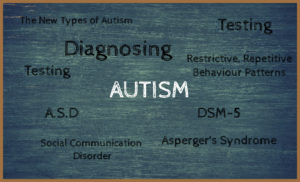In today’s article, I will discuss the test for autism. However, before we begin, let’s have a quick test on the autism test itself to make sure we’re all on the same level to begin. Ready? Ok! So, using the Diagnostic and Statistical Manual of Mental Disorders, which out of the following options, is currently a medically identified diagnosis, that someone who shows signs of autism can be given?
A. High Functioning Autism
B. Asperger’s syndrome
C. Rett syndrome
Picked an answer yet? Ok, well If you answered either A, B or C, then sadly you have failed the autism test, test.
Welcome to the confusing world of autism diagnosis. A place where most of what you know is likely to be out of date, and the things you considered to be fact, probably never were. But fret not, because this is also a place I hope to make a lot clearer by the end of this article.
[Disclaimer: This article aims to differentiate the various forms of autistic spectrum disorder, and discuss the ‘autism test’ in which someone can be diagnosed with autism: according to the DSM-5. In future posts, I plan to cover other autism tests, such as those found in the ICD, but for now, I want to focus on the most recent (and most controversial) of these manuals: the DSM.]

What is the Diagnostic Manual of Mental Disorders?
So I’m going out on a limb here, but I’m guessing the question most of you are currently asking is, ‘since when wasn’t Asperger’s a form of autism?’ The answer to this is simple: 2013… The reasoning is a bit more complex.
In 2013, the world of autism was rocked when the fifth edition of the Diagnostic and Statistical Manual of Mental Disorders (or DSM-5) was released. If this means as little to you as it did to me, all you need to know is that the DSM has been dubbed ‘‘the psychiatrists’ bible”, and 5 years ago it was rewritten.
From changing the very name of autism from ‘Autistic Disorder’, to ‘Autistic Spectrum Disorder’, to changing the way in which it’s diagnosed. Once the DSM-5 was released, there were very few similarities between what we had come to know of autism, and what it is now (medically speaking of course).

The New Types of Autism:
One major change which happened with the DSM-5 was that, in place of the previous classification system, people taking an autism test are now to be diagnosed via 2 areas:
- Social Communication Impairments: How well we get on with others
- Restrictive, Repetitive Behaviour Patterns: How much we are limited by our behaviours e.g. interests/obsessions
These 2 areas are then given a level of 1-3, where each new level reflects how much support a person needs:
Level 1 = Requiring Support
Level 2 = Requiring substantial support
Level 3 = Requiring very substantial support
Level 4 = Requiring super-duper, very substantial support (I may have made this one up)
It all sounds very simple when you lay out it like this. However, when it comes to autism diagnosis, things are rarely that simple… unless you already have an autistic diagnosis.

What do the new types of autism diagnosis mean for people with old diagnoses?
Something which I personally love way more than I probably should is that for people like me, who have already been diagnosed as autistic, our diagnosis has not been changed to meet the new criteria.
So, anyone with a diagnosis of autism pre-2013, will continue to have Asperger’s or Atypical Syndrome or what-ever loose label we achieved during the time when it was relevant. As more diagnosis is made through the new system, our current categories will slowly head towards extinction (In my mind this puts us in the running for a new Walking with Dinosaurs spin-off – ‘The Last Days of the Aspies’, [narrated by Sir David Attenbrough]).

What does this mean for people currently awaiting diagnosis?
When it comes to looking at the pros and cons of these changes, I understand that most people who are waiting for a diagnosis are less than impressed. Despite this, today I wanted to create a balanced argument for the DSM-5, as I believe that the publication does have the potential for good… and then I will discuss its blatant flaws and come to a conclusion on why it is indeed rubbish.
Pros:
- A more accurate title: Changing the name of autism to ‘Autistic Spectrum Disorder’ may seem like a small change to most. However, for people who are ‘freshly’ diagnosed with autism, it lets them know immediately that, even though they are now ‘autistic’, this word won’t define them: as there is still a whole spectrum of possibilities (now if they could only remove ‘disorder’ from its title).
- It makes things clearer (kind of): I understand that most people who are autistic (and most who aren’t) dislike change, but if you look at the old way of diagnosing, it’s hard to say it was perfect. With previous types of autism including names such as: Asperger’s Syndrome, Atypical Autism and Autistic Disorder, most people with autism didn’t understand what their diagnosis means, even after receiving it.
- [and come on, one of the previous autistic subcategories was literally called ‘autistic disorder’, how confusing is that!?]
- ‘Levels’ is better than ‘Functioning’: As stated in the intro, there isn’t/never was such a thing as ‘high/low functioning autism’. This is for good reason, as it makes people who are described as ‘low function’ feel like they have nothing to offer, which of course we/they do.
- Bringing in the new levels systems is a way to update these offensive descriptions without having to ban them. By saying someone needs a lot of support, you are acknowledging both a person’s potential and the difficulties which stand in the way of achieving it.

Cons:
- Level of support is not a diagnosis: It’s probably obvious, but diagnosing someone with ‘needing support’ is not really a diagnosis at all. Support is something which can constantly change throughout a person’s life. Whereas autism is something which, for better or worse, we are stuck with.
- There are more issues that people with autism face, other than their diagnosis: As I mentioned previously (in my Autism and Anxiety post), people who are described as ‘high functioning’ or ‘level 1’ are most at risk of having anxiety. Labelling these same people as needing the least support could increase this threat to their mental health. This same logic applies to the many other conditions in which autism can be linked to.
- Social Communication Disorder the DSM-5 also introduced a new kind of diagnosis for people showing signs of autism, but rank lower than level 1. This new classification is known as ‘Social Communication Disorder’ (or SCD) and for many on the spectrum, it has become a kind of purgatory.
- In a sense SCD can be interpreted as ‘autism-light’, as it is viewed similarly to standard autism, only people who are diagnosed with it aren’t given the same level of support. This once again demonstrates the issues with the support system: as it can put someone with autism in a constant flux of needing support, getting support and then being assigned less support, as they do better.
- The DSM-5 increases the chances of false diagnosis: One worrying issue, regarding the DSM-5, is how much easier it is to get a diagnosis of autism under the new rules. All you need to do now is to show you have one of the two previously mentioned areas (on any level) and poof! you’re on the spectrum. It has been stated that this may account for why we are seeing a rising number of people with autism: from 1 in 100 to 1 in 68. Although you will find people arguing that this is because the DSM-5 is doing a top job…it’s not.
- My pro’s list wasn’t really PROgressive: Though I have tried to give equal weight to the pros and cons list of the DSM-5, it must be stated that most of the positives which I have given, can easily be described as things which are ‘nice’ but in the long term don’t make too much of a difference. This is the overall problem that many have with the DSM-5 (myself included), but does this mean the DSM-5 is irreparable?

3 Recommended Changes for the DSM-5 (Academic):
Before I finish today, I wanted to look at some of the possible changes which could help improve the current way in which autism diagnosis is made under the DSM-5. These recommendations are stolen adapted from discussions which I have read in online academic journals. To ensure that everyone gets their deserved credit, I will be including clickable links to the original documents in bold red:
- Clarify what ‘support’ means: If we are going to keep the current method of diagnosing someone by the level of support, then it’s highly recommended that the DSM-5 describes what this ‘support’ actually is. You could say that it’s a good thing that every person on the spectrum is currently receiving help tailored to their needs, but as the purpose of the DSM-5 is to help doctors with patients, you would at least think that it would give an opinion on how.
- Either get rid of all the old classifications or don’t get rid of any: As much as it pains me to say it, it’s probably time to let go of the old subcategories for autism. I understand it would be time-consuming (and presumably expensive) to re-diagnose everyone who is currently walking around with a diagnosis of Asperger’s, Atypical Syndrome or whatever. However, unless these people stay with the same medical practitioner our whole lives, then we are going to struggle to get relevant help when we approach someone trained in the new way of diagnosing.
- Don’t help people with autism, help people trying to help people with autism: By eliminating the classification system and focusing on one of two impairments, we are not only focusing on the negative traits which autism can give, but we are also making diagnosis too open for interpretation.
- Medical staff need classifications, as classifications give them directions. They don’t need the biggest revision of something they rely on, to be a change which only serves to make things less offensive (and then fail anyway). What doctors, nurses, therapist and so on need, is something which can help them speed up the diagnosis process. An urgent demand considering the current shambles, which is a 44 month waiting list with the NHS.

How the DMS-5 should change (opinion):
I can’t tell you what was going inside the minds of the DSM-5’s authors when it was written, but from what I have researched and inferred from other sources, it seems that instead of pushing forward advances in autism diagnostics, the DSM-5 instead tried to create a more civil world for those being diagnosed.
I’m aware that what I am about to say may be an unpopular opinion, but this needs to change.
Medical staff ought to focus on autism as something which can hinder a lifestyle, not something which, if supported, can be a blessing. If doctors are going to take someone with autism seriously they can’t afford to be wasting time with terminology which only serves to make the process more politically correct.
Autism is an invisible condition and as such there are so many risks to mental health that can come with, or develop adjacently to it. If you teach a doctor to focus on the benefits of autism, these illnesses, which are a very real threat, could easily be overlooked. As such the DSM-5 creates an opportunity for these conditions, like Anxiety or OCD, to pose an even greater danger to those of us with autism.
I want to reiterate that I have no insider information on the authors of the DSM-5. However, I have no doubt that their intention were good: unfortunately, this has backfired and have now become a larger problem. This is why it’s important to state, that next time these authors do regroup, they are made aware of articles like this, so they can realise that being nice has got us nowhere and maybe a tactic of ‘tough love’ is what’s best for the DSM-6.

Carry on the Conversation
Am I wrong for feeling this way? Possibly. So let me know what you would like to see introduced in the next edition of the DMS in the comments below.
Don’t forget you can sign up to the blog’s newsletter by completing the online form, found on the sidebar (or below on mobiles).
As always, I can be found on Twitter @AutismRevised and via my email: AutisticandUnapologetic@gmail.com
If you like what you have seen on the site today, then show your support by liking the Autistic & Unapologetic Facebook page.
Thank you for reading and I will see you next Saturday for more thoughts from across the spectrum.


